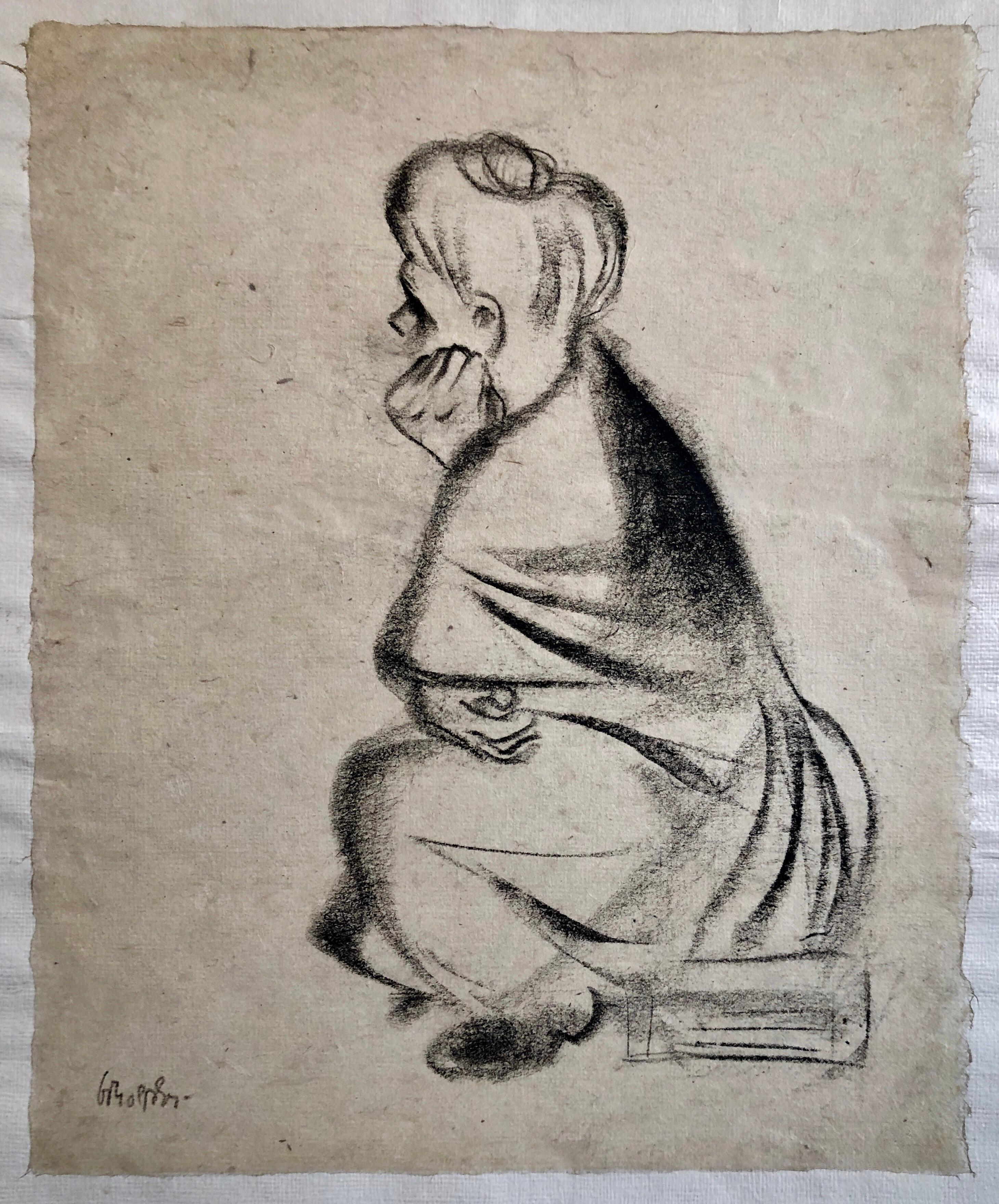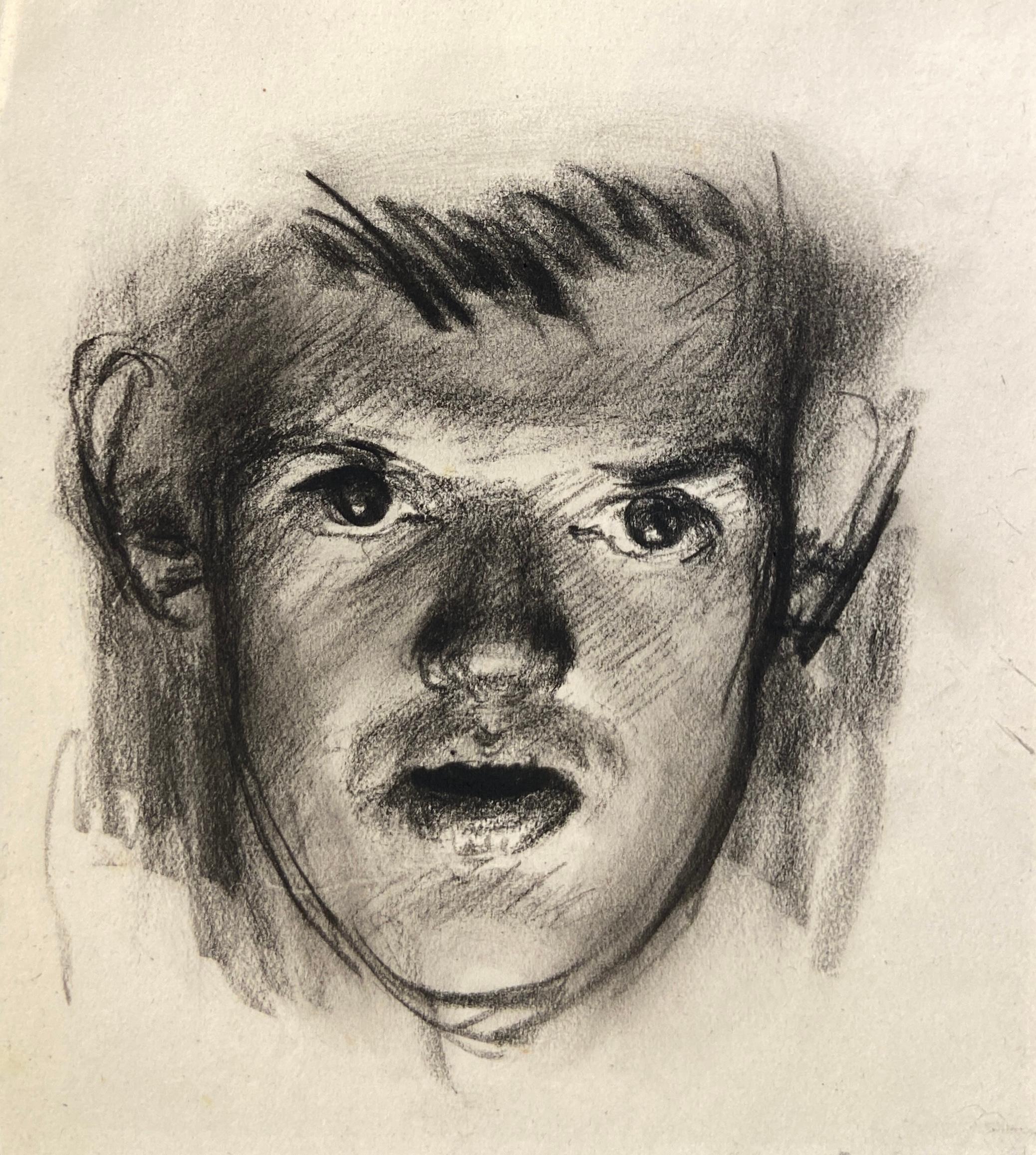Peter Collins ARCAPeter Collins ARCA - 20th Century Charcoal Drawing, Study of a Woman IIUnknown
Unknown
About the Item
- Creator:Peter Collins ARCA (1923 - 2001, British)
- Creation Year:Unknown
- Dimensions:Height: 22.37 in (56.8 cm)Width: 18.43 in (46.8 cm)
- Medium:
- Period:
- Condition:In fine condition overall, with minor surface Marks.
- Gallery Location:Corsham, GB
- Reference Number:
Peter Collins ARCA
With a fondness for life drawing, Peter Collins ARCA was perhaps a natural choice for the bikini-clad inhabitants of the pages of a holiday brochure. Collins's first job was at an advertising agency, in the commercial studio, while he attended evening art classes. World War II interrupted his career and he joined the Royal Artillery (of the British Army), teaching painting and drawing in the Education Corps, while simultaneously teaching at St Martin's School of Art, part time. Following the war, Collins studied at the Royal College of Art, winning a scholarship. Leaving in 1950, he then worked as a commercial artist producing some well-known posters for clients including British Railways and British European Airways. He was the Art Director at Odhams Press and spent time designing for both ICI and Shell. With his wife Georgette, he created the 'Bacombe Galleries' in Sussex, converting a group of buildings. In 1975, they again converted buildings, this time Stanley Studios in Chelsea, which were scheduled for redevelopment; many artists had worked there, probably the most famous being Elizabeth Frink. Combining an artist's studio and a single residence at Stanley Studios, the Collins’ were immersed in Chelsea's art scene and proceeded to fill the place with art, antiques, sculptures and curios.
- ShippingRetrieving quote...Ships From: Corsham, United Kingdom
- Return PolicyA return for this item may be initiated within 30 days of delivery.
- Ellie Lishman - 1992 Charcoal Drawing, Portrait of Dylan ThomasLocated in Corsham, GBA charming charcoal drawing depicting the Welsh poet Dylan Thomas. The artist captures his signature wild hair and thoughtful look through this expressive po...Category
21st Century and Contemporary Portrait Drawings and Watercolors
MaterialsCharcoal
- Alfred Kingsley Lawrence RA (1893-1975) - Charcoal Drawing, Nude StudyBy Alfred Kingsley Lawrence RALocated in Corsham, GBA fine and elegant graphite study by the artist Alfred Kingsley Lawrence, depicting a nude female figure. The fine lines and expressive nature of the composition, illustrate the arti...Category
20th Century Portrait Drawings and Watercolors
MaterialsCharcoal
- R. Falk - American School 19th Century Charcoal Drawing, Orlando MontagueLocated in Corsham, GBThis charming portrait depicts a man in fine clothing drawn in charcoal and chalk. Label verso titles the painting 'Orlando Montague of Bridgton, Maine' Signed under the mount. Prese...Category
19th Century Portrait Drawings and Watercolors
MaterialsCharcoal
- Emily Ashman - Fine 1831 Charcoal Drawing, Classical LadyLocated in Corsham, GBA very fine study of a young woman in classical Greek dress. The artist has captured the subject with a look of intrigue, her hand raised as if pondering a question. Very finely pres...Category
Early 19th Century Portrait Drawings and Watercolors
MaterialsCharcoal
- Early 19th Century Charcoal Drawing - DaydreamingLocated in Corsham, GBA charming charcoal study depicting a woman in classical dress looking up with a distance, dreamy look. The artist captures the woman using delicate cross hating to highlight the con...Category
Early 19th Century Portrait Drawings and Watercolors
MaterialsCharcoal
- Mid 19th Century Charcoal Drawing - The Day's BagLocated in Corsham, GBA charcoal and chalk drawing en grisaille depicting a man returning from a day of crane hunting with his bag slung over his shoulder. Drawn in fine detail using an excellent percepti...Category
Mid-19th Century Portrait Drawings and Watercolors
MaterialsCharcoal
- Old Jewish Shtetl Rabbi Charcoal Judaica Drawing World War II EraBy Maurycy TrebaczLocated in Surfside, FLMaurycy Trębacz (1861 – 1941) was one of the most popular Jewish painters in Poland in the late 19th and early 20th century. Many of his paintings were lost in the Holocaust, but a r...Category
1930s Expressionist Figurative Drawings and Watercolors
MaterialsPaper, Charcoal, Graphite
- Rare Modernist Hungarian Rabbi Pastel Drawing Gouache Painting Judaica Art DecoBy Hugó ScheiberLocated in Surfside, FLRabbi in the synagogue at prayer wearing tallit and tefillin. Hugó Scheiber (born 29 September 1873 in Budapest – died there 7 March 1950) was a Hungarian modernist painter. Hugo Scheiber was brought from Budapest to Vienna at the age of eight where his father worked as a sign painter for the Prater Theater. At fifteen, he returned with his family to Budapest and began working during the day to help support them and attending painting classes at the School of Design in the evening, where Henrik Papp was one of his teachers. He completed his studies in 1900. His work was at first in a post-Impressionistic style but from 1910 onward showed his increasing interest in German Expressionism and Futurism. This made it of little interest to the conservative Hungarian art establishment. However, in 1915 he met the great Italian avant-gardist Filippo Tommaso Marinetti and the two painters became close friends. Marinetti invited him to join the Futurist Movement. The uniquely modernist style that he developed was, however, closer to German Expressionism than to Futurism and eventually drifted toward an international art deco manner similar to Erté's. In 1919, he and his friend Béla Kádar held an exhibition at the Hevesy Salon in Vienna. It was a great success and at last caused the Budapest Art Museum to acquire some of Scheiber's drawings. Encouraged, Scheiber came back to live in Vienna in 1920. A turning point in Scheiber's career came a year later, when Herwarth Walden, founder of Germany's leading avant-garde periodical, Der Sturm, and of the Sturm Gallery in Berlin, became interested in Scheiber's work. Scheiber moved to Berlin in 1922, and his paintings soon appeared regularly in Walden's magazine and elsewhere. Exhibitions of his work followed in London, Rome, La Paz, and New York. Scheiber's move to Germany coincided with a significant exodus of Hungarian artists to Berlin, including Laszlo Moholy-Nagy and Sandor Bortnyik. There had been a major split in ideology among the Hungarian avant-garde. The Constructivist and leader of the Hungarian avantgarde, Lajos Kassák (painted by Hugó Scheiber in 1930) believed that art should relate to all the needs of contemporary humankind. Thus he refused to compromise the purity of his style to reflect the demands of either the ruling class or socialists and communists. The other camp believed that an artist should be a figurehead for social and political change. The fall out and factions that resulted from this politicisation resulted in most of the Hungarian avant gardists leaving Vienna for Berlin. Hungarian émigrés made up one of the largest minority groups in the German capital and the influx of their painters had a significant effect on Hungarian and international art. Another turning point of Scheiber's career came in 1926, with the New York exhibition of the Société Anonyme, organized by Katherine Dreier. Scheiber and other important avant garde artists from more than twenty-three countries were represented. In 1933, Scheiber was invited by Marinetti to participate in the great meeting of the Futurists held in Rome in late April 1933, Mostra Nazionale d’Arte Futurista where he was received with great enthusiasm. Gradually, the Hungarian artists began to return home, particularly with the rise of Nazism in Germany. Kádar went back from Berlin in about 1932 and Scheiber followed in 1934. He was then at the peak of his powers and had a special flair in depicting café and cabaret life in vivid colors, sturdily abstracted forms and spontaneous brush strokes. Scheiber depicted cosmopolitan modern life using stylized shapes and expressive colors. His preferred subjects were cabaret and street scenes, jazz musicians, flappers, and a series of self-portraits (usually with a cigar). his principal media being gouache and oil. He was a member of the prestigious New Society of Artists (KUT—Képzőművészek Új Társasága)and seems to have weathered Hungary's post–World War II transition to state-communism without difficulty. He continued to be well regarded, eventually even receiving the posthumous honor of having one of his images used for a Russian Soviet postage stamp (see image above). Hugó Scheiber died in Budapest in 1950. Paintings by Hugó Scheiber form part of permanent museum collections in Budapest (Hungarian National Museum), Pecs (Jannus Pannonius Museum), Vienna, New York, Bern and elsewhere. His work has also been shown in many important exhibitions, including: "The Nell Walden Collection," Kunsthaus Zürich (1945) "Collection of the Société Anonyme," Yale University Art Gallery, New Haven, Connecticut (1950) "Hugó Scheiber: A Commemorative Exhibition," Hungarian National Museum, Budapest (1964) "Ungarische Avantgarde," Galleria del Levante, Munich (1971) "Paris-Berlin 1900-1930," Centre Georges Pompidou, Paris (1978) "L’Art en Hongrie, 1905-1920," Musée d’Art et l’Industrie, Saint-Etienne (1980) "Ungarische Avantgarde in der Weimarer Republik," Marburg (1986) "Modernizmus," Eresz & Maklary Gallery, Budapest (2006) "Hugó Scheiber & Béla Kádár," Galerie le Minotaure, Paris and Tel Aviv (2007) Hugó Scheiber's paintings continue to be regularly sold at Sotheby's, Christie's, Gillen's Arts (London), Papillon Gallery (Los Angeles) and other auction houses. He was included in the exhibition The Art Of Modern Hungary 1931 and other exhibitions along with Vilmos Novak Aba, Count Julius Batthyany, Pal Bor, Bela Buky, Denes Csanky, Istvan Csok, Bela Czobel, Peter Di Gabor, Bela Ivanyi Grunwald, Baron Ferenc Hatvany, Lipot Herman, Odon Marffy, C. Pal Molnar...Category
Early 20th Century Modern Figurative Paintings
MaterialsPaper, Charcoal, Pastel, Watercolor, Gouache
- Charcoal Drawing "Waiting" Pensive Woman Americana WPA ArtistBy William GropperLocated in Surfside, FL14x11.5 image size , 22.5x17.5 backing size The New-York born artist William Gropper was a painter and cartoonist who, with caricature style, focused on social concerns, and was ac...Category
Mid-20th Century Modern Portrait Drawings and Watercolors
MaterialsCharcoal
- Self Portrait, Charcoal on Paper, 20th Century British DrawingBy William DringLocated in London, GBCharcoal on paper Image size: 4 1/2 x 4 1/4 inches (11.5 x 10.75 cm) Mounted with a contemporary style frame This is a somewhat haunting self-portrait by William Dring, crafted in c...Category
20th Century Modern Portrait Drawings and Watercolors
MaterialsPaper, Charcoal
- Portrait of a Young Man, 19th Century English, Charcoal, Signed and Dated '1888'Located in London, GBCharcoal on paper, signed and dated '1888' bottom right Image size: 9 x 7 1/2 inches (22.75 x 19 cm) Period frame The half-length portrait depicts the subject sat, wearing a white s...Category
1880s Victorian Portrait Drawings and Watercolors
MaterialsPaper, Charcoal
- Portrait of a Young Man, Charcoal 1800 French School, RomanticismLocated in London, GBCharcoal and grey wash on paper Image size: 14 3/4 x 13 3/4 inches (37.5 x 36 cm) Provenance Private collection, Washington DC. C.G. Sloan & Co., Sept. 1980. This charcoal portrait...Category
Early 1800s Portrait Drawings and Watercolors
MaterialsCharcoal, Paper





